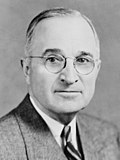| |||||||||||||||||||||||||
| |||||||||||||||||||||||||
 First place by popular vote
| |||||||||||||||||||||||||
| |||||||||||||||||||||||||
From March 9 to June 1, 1948, presidential primaries were organized by the Democratic Party to select delegates to the 1948 Democratic National Convention, to determine the party's nominee for president in the 1948 United States presidential election. The elections took place in 14 states where delegates were chosen in primary elections. [1]
Contents
Incumbent president Harry S. Truman won eight contests, while uncommitted delegates won the remaining six. Truman was ultimately nominated for re-election at the Democratic National Convention in Philadelphia. [2]


